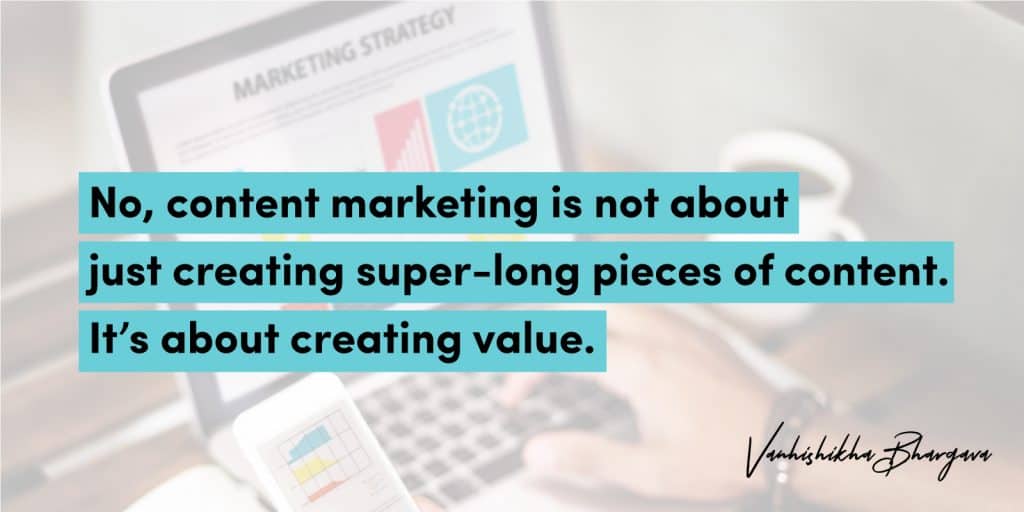
Content Marketing Myth 9
No, content marketing is not about just creating super-long pieces of content. It’s about creating value.
When I said consistent, I definitely did not mean you should be creating 5000 words long content pieces every week. Whoever said that in the first place?
Yes, there have been multiple studies showing how longer pieces of content perform better. They rank better. They get more conversions. That’s all true!
But nowhere in those studies did it say anything like – ‘only’ long content works best, you ‘only’ need to create long pieces of content, your ‘only’ focus needs to be writing an essay on any topic you pick.
Those studies spoke about ‘adding value’ and then the length of the content piece you’re planning to publish. Simply put, they’re not asking you to pour your heart out and become a poet. They’re suggesting adding as much value to the reader as possible, with everything you know about what you’re writing on.
For example, going back to two content pieces I have written. One that is so extensive that the designer creating the graphics for it, was crying by the end of it. Two, was a simple infographic supported by some text in the article to explain the same.
The impact of both? 500+ visitors within a week WITHOUT paid promotions or aggressively spamming people with their links.
So what happened here?
The first piece was around a topic that the audience would typically have to move from one piece to another to learn. They would have to search for the best article on each step as they moved along, then look for a clear how-to and then finally implement the solution, if they don’t give up mid-way. So we made their learning journey easy by creating a complete guide – A to Z covered in one go; broken into consumable content marketing myths that they could come back to every day and use as a how-to.
The second piece was around a topic that the audience typically wanted a quick checklist for. To make this clearer, they simply needed to know how to choose the right apps for their business. Now typically, they’d counter articles with the title that matched their search but listed down apps instead. Or in another case, they found articles beating about the bush about what needs to be kept in mind – in 2000+ words.
Come to think about it, who wants to go through a 2000+ words recipe when all they wanted was a quick step-by-step?
So instead of just writing this content piece in text format, we chose to make an infographic out of it. The infographic walked through the reader through all the parameters that they need to keep in mind when choosing an app and the questions they need to ask to make the final decision. No frills and visual – it automatically got consumed and understood way faster!
Yes, there is no denying that longer content pieces perform well.
But it’s also proven by the likes of Moz that long-form content isn’t always necessary and may actually be counterproductive. It all depends on what your business does, what you’re trying to achieve from a content piece and who you’re addressing.
If you’re explaining a bigger issue that an audience needs to move door to door to understand, go ahead and write out that 3000+ words article.
If you’re simply addressing a quick query that you personally would have wanted a 1 min conversation on, don’t be afraid to push out just 500 words.
What have I learned and what do I recommend?
Just the above.
But also that you should continually test your approach.
As you optimize your content marketing strategy to incorporate more of your audience’s interests, make sure you also test different content formats. And by that I also mean the length of your content pieces.
This will give you an idea of how willing your audience is to learn and how dedicated they can remain when consuming that long-form content.
Pro tip: If you’re publishing long-form content, make sure you’re using a table of contents and have set up easy navigation to make it easier to read through the post. Also include a lot of rich media like graphics, videos, GIFs – if nothing else, free stock images and screenshots work just fine. If you’re pushing out a short piece of content, make sure you’re getting to the point immediately and use a format that is quick to browse through.
